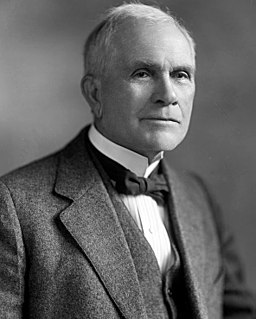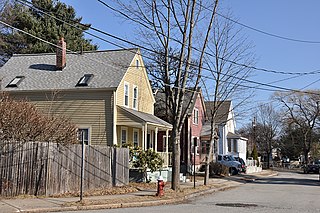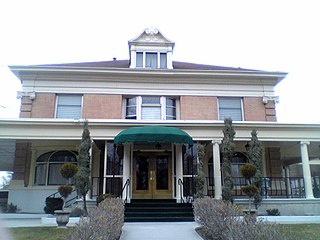Russell Family Historic District | |
 | |
| Location | 35, 65, 85 N. Central, 228, 334 Robin Hill, 101 Russwood, Alexander City, Alabama |
|---|---|
| Coordinates | 32°56′36″N85°57′43″W / 32.94333°N 85.96194°W Coordinates: 32°56′36″N85°57′43″W / 32.94333°N 85.96194°W |
| Area | 50 acres (20 ha) |
| Built | 1913 |
| Architectural style | Colonial Revival, Classical Revival |
| NRHP reference # | 05000839 [1] |
| Added to NRHP | March 21, 2006 |
Russell Family Historic District is a historic district in Alexander City, Alabama. The district is a collection of houses built by the family of Benjamin Russell. Russell and his children founded the Citizens' Bank of Alexander City in 1900, followed by the Russell Manufacturing Company in 1902. The company, along with B. B. Comer's Avondale Mills, turned Alex City into one of the textile centers of the South.

Alexander City, known to locals as "Alex City", is a city in Tallapoosa County, Alabama, United States, with a population of some 14,875. It is known for Lake Martin with its 750 miles (1,210 km) of wooded shoreline and 44,000 acres (18,000 ha) of water. Lake Martin stands on the Tallapoosa River and offers boating, swimming, fishing, golfing, and camping. Many neighborhoods and luxury homes are located on the lake.

Russell Athletic is an American sports equipment manufacturer based in Bowling Green, Kentucky. Currently a subsidiary of global company Fruit of the Loom, Russell Athletic was the main brand of Russell Brands, LLC. until its acquisition in 2006.

Braxton Bragg Comer was the 33rd Governor of Alabama from 1907 to 1911, and a United States Senator in 1920. As governor, he achieved railroad reform, lowering rates for businesses in Alabama to make them more competitive with other states. He increased funding for the public school system, resulting in more rural schools and high schools in each county for white students, and eventually a rise in the state's literacy rate.
In 1913, the family built several houses on a hillside overlooking the mills. Benjamin's youngest son, Ben, built a Classical Revival house with a hip roof and façade dominated by four columns with Corinthian capitals. Benjamin's sister, Sally, built a brick, Classical Revival residence with doubled Ionic columns. Thomas Commander Russell, Benjamin's brother who served as Alex City's mayor from 1907 until 1947, built a tan brick Craftsman-style house.

A hip roof, hip-roof or hipped roof, is a type of roof where all sides slope downwards to the walls, usually with a fairly gentle slope. Thus a hipped roof house has no gables or other vertical sides to the roof.

The Corinthian order is the last developed of the three principal classical orders of ancient Greek and Roman architecture. The other two are the Doric order which was the earliest, followed by the Ionic order. When classical architecture was revived during the Renaissance, two more orders were added to the canon, the Tuscan order and the Composite order. The Corinthian, with its offshoot the Composite, is the most ornate of the orders. This architectural style is characterized by slender fluted columns and elaborate capitals decorated with acanthus leaves and scrolls. There are many variations.

The Ionic order forms one of the three classical orders of classical architecture, the other two canonic orders being the Doric and the Corinthian. There are two lesser orders: the Tuscan, and the rich variant of Corinthian called the composite order, both added by 16th-century Italian architectural writers, based on Roman practice. Of the three canonic orders, the Ionic order has the narrowest columns.
In 1937, the second generation of the family began to build on the family land. Elisabeth, Benjamin's daughter, built a Classical Revival house inspired by the "Tara House" from the film Gone with the Wind . The next year, Thomas Russell built a Colonial Revival near-replica of George Washington's Mount Vernon. In 1946 Robert Russell built a house with decorative, wrought iron railings evocative of houses in New Orleans and Monterrey, Mexico. [2]

Gone with the Wind is a 1939 American epic historical romance film adapted from the 1936 novel by Margaret Mitchell. The film was produced by David O. Selznick of Selznick International Pictures and directed by Victor Fleming. Set in the American South against the backdrop of the American Civil War and the Reconstruction era, the film tells the story of Scarlett O'Hara, the strong-willed daughter of a Georgia plantation owner. It follows her romantic pursuit of Ashley Wilkes, who is married to his cousin, Melanie Hamilton, and her subsequent marriage to Rhett Butler. The leading roles are played by Vivien Leigh (Scarlett), Clark Gable (Rhett), Leslie Howard (Ashley), and Olivia de Havilland (Melanie).

Colonial Revival architecture was and is a nationalistic design movement in the United States and Canada; it seeks to revive elements of architectural style, garden design, and interior design of American colonial architecture.

George Washington was an American political leader, military general, statesman, and Founding Father who served as the first president of the United States from 1789 to 1797. Previously, he led Patriot forces to victory in the nation's War for Independence. He presided at the Constitutional Convention of 1787 which established the U.S. Constitution and a federal government. Washington has been called the "Father of His Country" for his manifold leadership in the formative days of the new nation.
The district was listed on the National Register of Historic Places in 2006. [1]

The National Register of Historic Places (NRHP) is the United States federal government's official list of districts, sites, buildings, structures and objects deemed worthy of preservation for their historical significance. A property listed in the National Register, or located within a National Register Historic District, may qualify for tax incentives derived from the total value of expenses incurred in preserving the property.























